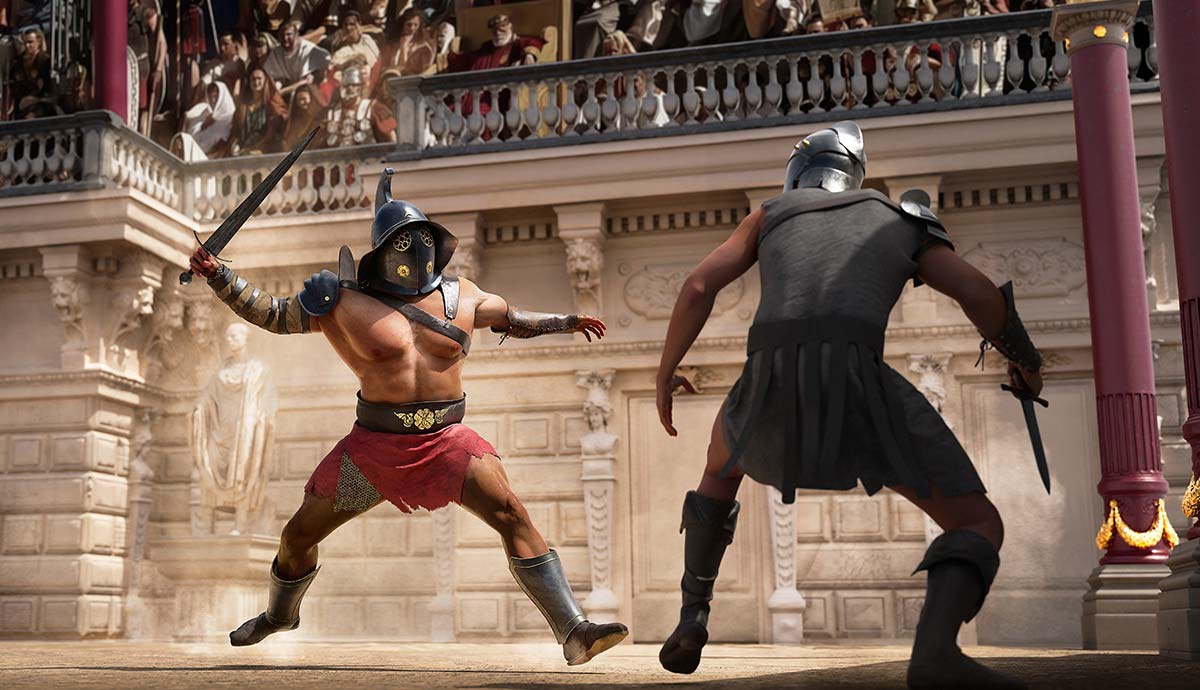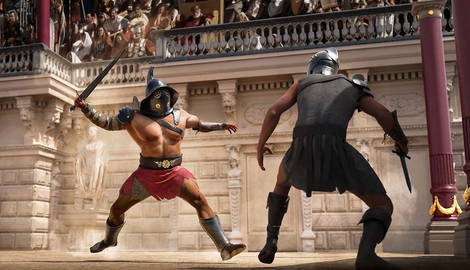
A tradition stemming from the earlier Etruscans, gladiators appeared in Rome in 264 BCE. Gladiatorial games embodied the broader social context of their time. A gladiator was either a slave or a criminal, and the games were a way to redeem themselves from their criminal charges or fight for their freedom. The games quickly became a political tool. Gladiators provided a spectacle under controlled, albeit brutal, conditions to deter viewers from enacting the same crimes that had condemned the gladiators to the arena. Essentially, those who abused the social order would suffer the same brutality in front of hundreds of Roman civilians who valued a pervasive culture of violence.
Origins of the Gladiators

Originally, gladiatorial games were an homage to the dead. Armed combat was a funerary tribute to the dead, a kind of blood sacrifice believed to placate the dead. The first recorded gladiatorial funeral rite was for Giunus Brutus Pera in 264 BCE. However, as time passed, the games lost their ceremonial purpose. They became increasingly performative, warping into a form of sport-related entertainment.
In 105 BCE, the consuls P. Rutilius Rufus and Cn. Manilus Maximus arranged games for their political campaigns. From then on, the games became a way for politicians to curry favor with the public. The promise of being reelected was stronger if they sponsored the games generously. By the end of the republic, the games were so costly that Marcus Tullius Cicero passed a law that prohibited public figures from offering gladiatorial combat in the two years preceding their election to public office.
Recruiting Gladiators

Most gladiators were recruited from two groups: slaves and free volunteers. Slaves had no choice when becoming gladiators. Their master would sell them to a gladiatorial agent. Meanwhile a volunteer signed himself to one. Consequently, a volunteer would surrender his civilian rights and consent to the violence he would inevitably experience in the arena. Unlike a slave, a volunteer received a signing bonus, and the prospect of prize money (if they won a battle), and his chances of glory advanced with every successful fight. A slave, if they served a minimum of three years, would be granted their freedom. Yet, this seldom occurred as most slave-gladiators died in the arena or served out the remainder of their lives as gladiators.
The other sub-group from which gladiators were drawn were criminals. In ancient Rome, a criminal would either be condemned “to the sword” (ad gladium) or condemned “to the training school” (ad/in ludum). While in most cases both were death sentences, by becoming a gladiator, the criminal could survive their sentence and win their freedom.
Daily Operations of the School

Gladiators trained within a ludus gladiatorius, an institution managed by a lanista. Some ludus, however, were owned by wealthy investors who housed and trained troupes of gladiators, a familia gladiatoria. In smaller gladiatorial establishments, the lanista doubled as a trainer, whereas in larger, more renowned training schools such as the Ludus Magnus, a magistra taught specific types of gladiatorial combat.
The lanista ran the business side of the schools, leasing out the gladiators to wealthy nobles for gladiatorial shows, or munus. Superior gladiators with excellent weaponry skills were more expensive to hire, and these men were typically volunteer gladiators. Working under contract, however, was no different to the regime a slave followed in the gladiatorial schools. Both were beaten, whipped, and renounced their social privileges. As a gladiator, slave or contracted, they were fundamentally social outcasts.
Train Like a Gladiator

Within the confines of the school, the gladiators trained at different posts. These followed a hierarchical rank from primus palus, the first post, right through to the eighth stratum, the lowest ranking. At the Carnuntum and the Ludus Magnus, the inside was shaped like an arena, which mimicked the landscape of the stadium. In Pompeii, the training arena was more rectangular.
The type of training a gladiator received was based on their suitability and aptitude for specific armatures. Gladiatorial combat was a performative spectacle as much as a brutal display of strength and vigilance. Recruits were, therefore, trained according to the type of combat spectators would most enjoy, and trainers could pick out which of the men were better suited for different types of combat.
Various types of blows and techniques were taught at the ludus gladiatorius. There was a horizontal stab (punctim) and the chop (caesim), which required the gladiator to raise their arm during close combat. Finally, there was a variation of the punctim, which was a reverse grip on the sword, stabbing downwards as though the blade were a dagger. Gladiators were taught to master lethal weaponry skills to the extent that a shallow 49-millimeter deep wound was fatal. Of course, killing their opponent too soon or without a drawn-out, bloody battle would make for a poor show in the arena. On the flip side, if the show went for too long, the gladiators ran the risk of displeasing the crowd. Knowing how to use their weapon effectively and performatively was paramount.
Accommodation and Feasting

The standard of living was sub-par for a gladiator. Men were housed in cramped quarters with several to a cell, sleeping on either cots or mattresses on the floor. The two gladiatorial schools in Pompeii were said to be relatively airy and open, unlike the congested pens of the Ludus Magnus and Carnuntum in Rome.
Gladiators followed a carbohydrate-heavy diet to support their training and because wheat and barley were relatively inexpensive. Dinner consisted of a heavy gruel of beans and barley, which was called sagina, but amongst the gladiators, this was known as hordearii or “barley men.”
Game Day

Originally, the games occurred at irregular intervals throughout the year, typically when the Romans believed it necessary to pacify the wrath of a god. By the end of the republic, however, historians contend there were 67 days allocated for games each year.
If there were animal displays, they were presented in the morning before the gladiatorial combats began in the afternoon. Public executions via large animals such as lions or bears would have taken place in the morning.
Types of Gladiatorial Combat

Gladiatorial contests occurred one pair at a time, and both opponents were matched based on their skill and size. They would enter the arena slowly so that the audience had the chance to size them up and hedge their bets on the winner. Then, without further stalling, the gladiators would fight until one of them won. The gladiators ensured they didn’t finish the duel too quickly, as it was ultimately a performative contest. Audiences wanted to witness a stylish, technical fight.
To entertain the crowd beyond their swordsmanship, gladiators were adorned in different regalia based on the tribe from which they originated. A popular battle was between the Samnite and the Retiarius. The Samnite wore a plumed helmet, carried an oblong shield, and a sword was his weapon of choice. The Retiarius wore no helmet but had an armlet on his left arm to protect his head from a side blow. Retiarius defended themselves with a large net and a long trident or spear.
Combat rarely ended with a death, unless the show had been advertised as a munus sine missione, a fight to the death. For a gladiator to surrender to their opponent, they would sink to the ground and raise a finger as a gesture of submission. His fate then was decided by the host of the show. The show host would receive a discount on every uninjured gladiator they returned to the school. Unless the gladiator was a convicted criminal condemned to death, it was cheaper to keep the gladiator alive.
Chariot Races

The chariot races were held in a circus arena with a racing floor, and most races required seven laps. On race days, 24 races were run, and the games commenced with a solemn procession, starting at the Capitol and descending through the arena gates between the carceres. The procession was led by the presiding magistrate, and in his wake followed the competitors and images of the gods. Between the races, orchestral performances and trick riders, such as the desultores, who leaped from one horse to another, dazzled the crowds.
Naumachia

The Colosseum games, first held under the emperor Titus in 80 CE, showcased some of the most extravagant gladiatorial combats ever. Two naval battles, Naumachia, were held at the Colosseum close to the date of its inauguration. Colossal lakes were excavated within the arena to mimic the naval landscape of famous battles like the Corcryreans destroying the Corinthian fleet. Often, the naval ships were filled with criminals rather than trained gladiators, and Naumachia was a form of public execution.
Venationes

Archaeologists have discovered holding cells beneath the Colosseum designed to release wild beasts into the arena. This form of brutalistic performance was known as Venationes. They were introduced when Italian expansion came into contact with Africa and the East. The Roman general Fulvius Nobilior was the first to exhibit a wild beast show in 186 BCE in celebration of his victory over the Aetolians. In later years, the hosts of the shows relied upon eastern governors to supply them with a variety of animals for the games, including panthers, lions, and even rhinoceroses.
If accounts from antiquity were true, 9,000 animals were slaughtered in a single show, either in fights between animals or hunted by one or more armed Roman huntsmen. Historians speculate that this number was vastly overestimated. Nonetheless, this number implies that large numbers of exotic animals were killed for the sake of entertainment.
Venationes were highly popular during the Empire and were a favored form of capital punishment. Lions and bears were set upon criminals in the arena, and audiences would flock to the stadium to witness their execution. Romans valued justice in whatever violent form it took.
The Price of Freedom

Winning gladiators were crowned with a laurel, and sometimes given a purse of coins, which was divided with their lanista. Marcus Aurelius set the dividends at 25% of the purse if free and 20% for slaves.
Experienced gladiators were known as veterans, and once they accrued enough wins, they could aspire to reach the status of primus palus, or “first stake.” Eventually, after serving their time and forging their career with the school, they could retire.
Receiving the rudis, a wooden sword, marked the end of their time in the arena. In rare cases, slaves who had worked their way up the gladiatorial hierarchy within the school were free to open their own businesses or move into the security trade (particularly during the tumultuous period of the late republic).
Even after retirement, some gladiators were coaxed back into fighting on a special occasion. The emperor Tiberius offered 100,000 sesterces to retired gladiators to fight in a game in honor of his late grandfather.
Gladiators epitomized the Roman values of valor and violence and purveyed the consequence of disobeying civil order. While their stage performances, chariot races, and athletic contests were idolized, their lives and social status were challenging. A gladiator generally lived and died fighting an endless battle within the munus. He was either a criminal, slave, or a volunteer hoping to attain fame and fortune. Perhaps some gladiators knew the chances were stacked against them, but they could only die trying to be the exception.








